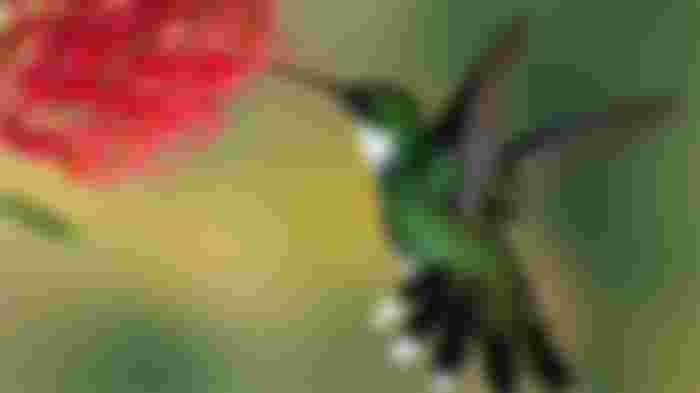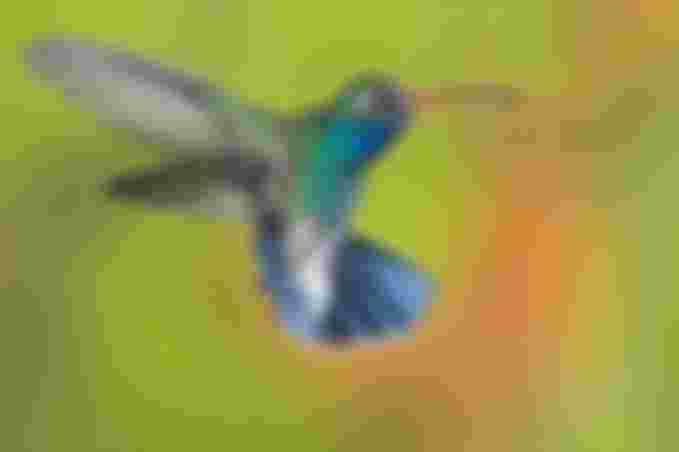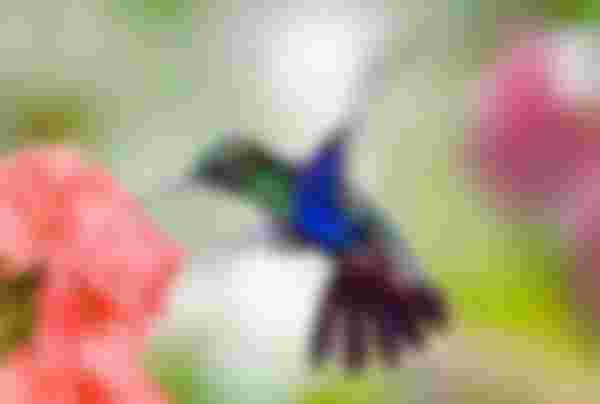
They are known as hummingbirds because of the hummingi sound created by their beating wings, which flap at high frequencies audible to humans. They hover in mid-air at rapid wing-flapping rates, which vary from around 12 beats per second in the largest species, to in excess of 80 in some of the smallest. Of those species that have been measured in wind tunnels, their top speeds exceed 15 m/s (54 km/h; 34 mph) and some species can dive at speeds in excess of 22 m/s (79 km/h; 49 mph).[1][2]
Hummingbirds have the highest mass-specific metabolic rate of any homeothermic animal.[3] To conserve energy when food is scarce, and nightly when not foraging, they can go into torpor, a state similar to hibernation, slowing their metabolic rate to 1/15th of its normal rate.[4]

Hummingbirds are restricted to the Americas from south central Alaska to Tierra del Fuego, including the Caribbean. The majority of species occur in tropical and subtropical Central and South America, but several species also breed in temperate climates and some hillstars occur even in alpine Andean highlands at altitudes up to 5,200 metres (17,100 ft).[100]

For nutrition, hummingbirds eat a variety of insects, including mosquitoes, fruit flies, gnats in flight or aphids on leaves and spiders in their webs.[112][113][114][115] The lower beak of hummingbirds is flexible and can bend as much as 25 degrees when it widens at the base, making a larger surface for catching insects.[114] Hummingbirds hover within insect swarms in a method called "hover-hawking" to facilitate feeding.[115]
To supply energy needs, hummingbirds drink nectar, a sweet liquid inside certain flowers. Like bees, they are able to assess the amount of sugar in the nectar they drink; they normally reject flower types that produce nectar that is less than 10% sugar and prefer those whose sugar content is higher. Nectar is a mixture of glucose, fructose, and sucrose, and is a poor source of nutrients, requiring hummingbirds to meet their nutritional needs by consuming insects.[114][115]
Hummingbirds do not spend all day flying, as the energy cost would be prohibitive; the majority of their activity consists simply of sitting or perching. Hummingbirds eat many small meals and consume around half their weight in nectar (twice their weight in nectar, if the nectar is 25% sugar) each day.[116] Hummingbirds digest their food rapidly due to their small size and high metabolism; a mean retention time less than an hour has been reported.[117] Hummingbirds spend an average of 10–15% of their time feeding and 75–80% sitting and digesting.

Tongue as a micropumpEdit
Hummingbirds drink with their long tongues by rapidly lapping nectar. Their tongues have tubes which run down their lengths and help the hummingbirds drink the nectar.[122] While capillary action was believed to be what drew nectar into these tubes, high-speed photography has revealed that the tubes open down their sides as the tongue goes into the nectar, and then close around the nectar, trapping it so it can be pulled back into the beak.[123][124] The tongue, which is forked, is compressed until it reaches nectar, then the tongue springs open, the rapid action traps the nectar and the nectar moves up the grooves, like a pump action, with capillary action not involved.[122][125] Consequently, tongue flexibility enables accessing, transporting and unloading nectar.[126][127]






wow.